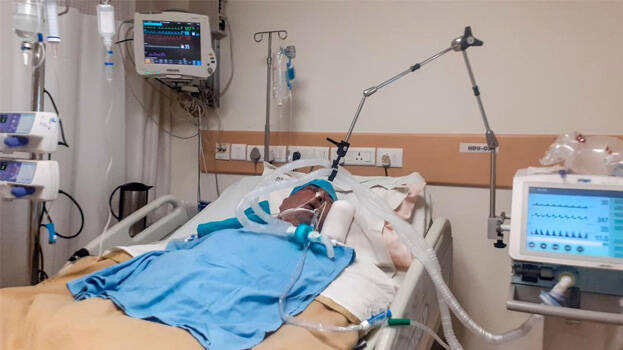

Rising healthcare costs notwithstanding, utilization of private healthcare services is increasing. The reasons are many and range from perceived apathy and unclean public health facilities to seeming high quality of care available in private hospitals. The trend continues despite the incomes of most Indians having either remained static or declined, given that the GDP per capita has decreased from US $2100 in 2019 to US $1900 in 2020 in the pandemic year. India’s healthcare system had systemic fault lines before the pandemic began. However, Covid-19 has exposed the fault lines to public scrutiny, and that is why blaming the private sector alone could be a knee-jerk reaction.
Healthcare financing in India
India’s public health expenditure has been dismal over the past years; its GDP expenditure on health has been between 1-1.8%. Public health expenditure in India is at three levels - Centre, state, and local self-government bodies. State governments have the lion’s share of around 63% in India’s total public health expenditure, compared to about 37% by the central government as of the fiscal year 2018. The division is made because the responsibility of providing primary health care resides with respective state governments under the Indian Constitution.
The Centre funds the National Health Mission (NHM) and other vertical programmes. The local self-government bodies are also responsible for funding and providing healthcare within their jurisdiction, and their share may vary. Apart from the three-tiered public health system (primary, secondary and tertiary levels reflected in primary health centres, district hospitals and medical colleges/ multi-specialty hospitals, healthcare is also provided by private healthcare providers for a fee. The costs of healthcare in the private sector are met through out-of-pocket (OOP) expenses in the majority of cases.
Health insurance is still gaining wide acceptance and is mostly employer-provided. The workforce in the organized sector continues to be covered with comprehensive social security legislation, including health under the Employment State Insurance Scheme (ESIS) that protects the employee and their families in case of sickness, disability, physical injury and provides for medical benefits when required. However, the scheme only covers 3.11% of the total workforce of the country . Approximately 38.5 lakh Central Government employees and pensioners are protected under the Central Government Health Scheme (CGHS) in 74 cities.
The biggest government-funded healthcare program Ayushman Bharat, or the National Health Protection Scheme, a public insurance provision, provides coverage up to INR 5 lakh every year to the vulnerable population on a family floater basis for secondary and tertiary care hospitalization. Furthermore, welfare funds have been created by Acts of parliament for specific occupational groups, including those in selected unorganised sector groups, like The Beedi Workers Welfare Fund Act, 1976 for beedi workers, The Plantation Labour Act, 1951 for plantation workers, to meet social security benefits like healthcare, education, recreation, water supply, and housing.
Despite these provisions, 86% of the rural population and 81% of the urban population are not covered under any scheme of health expenditure support, leading to approximately 62% of the total health expenditure borne by consumers themselves, as reported by an NSS survey published in 2019. As per a World Bank report, the OOP was 62.7% of the current health expenditure of India in 2018.
Increase in prices during Covid-19
Due to the risk associated with Covid-19, private hospitals hesitated to treat Covid-19 patients and even denied treatment to non-Covid-19 patients during the initial phase of the Covid-19 pandemic as they did not have the facilities to create separate isolation and treatment wards for Covid-19 patients. This resulted in a severe cash flow crunch as small and medium private hospitals didn't have the resources to keep the hospitals running, as suggested by a report prepared by the Federation of Indian Chambers of Commerce & Industry. Hospitals ended up charging high prices to cover their risk of externalities, like their medical staff testing positive during the treatment.
Based on the data published by the Ministry of Statistics and Programme Implementation (MOSPI) on May 14th, 2021, healthcare inflation rose to 7.8% in April 2021, a 20-month high. Item wise data indicates the rise in inflation was led by the cost of medicines, hospital charges, and x-rays. During the second wave, the demand for oxygen and medications was sky-rocketing, and India fell short on the supply side. This resulted in malpractices like hoarding essential medicines and oxygen tanks in the market. The increase in demand for health care services has also resulted in an increase in doctors’ fees in the private sector, as per the data published by the MOSPI.
The sporadic availability of public health facilities in urban and rural parts of India has left the burden on the private sector. In the absence of any competition from the public health sector over the past few years, there are allegations of exploitative prices and practices in private hospitals. The Economic Survey 2021 suggests an increase in public health expenditure as envisaged in the National Health Policy 2017 from 1% to 2.5% - 3% can bring the OOP to 30% from 60%. This level of expenditure should be maintained even after the impact of Covid-19 has decreased to ensure accessibility and affordability of healthcare. Although through the Ayushman Bharat scheme, treatments worth Rs 13,412 crore have been provided through a network of 21,565 public and private empanelled hospitals as of 2020, it has covered up to 1 crore treatments highlighting there is room for growth. The pandemic is a stark reminder of why universal primary healthcare coverage and awareness of operational insurance and other subsidies are essential to provide the general population with the best healthcare facilities without having to bear the burden of ruinous costs.